Exhibit 1. Job Satisfaction Among Registered Nurses, 2017
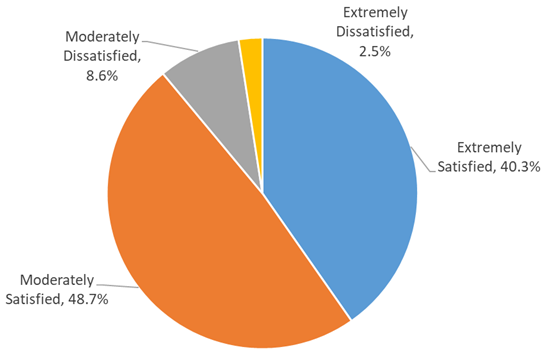
This brief provides information on job satisfaction among the 3,272,872 registered nurses (RNs) employed in the United States, based on the 2018 National Sample Survey of Registered Nurses (NSSRN).
The survey was administered between April and October 2018, with most information reported as of December 31, 2017. It does not reflect the impact of the COVID-19 pandemic on workforce morale. This brief will be updated when data from the 2022 NSSRN becomes available.
The majority of registered nurses (RNs) were either moderately satisfied (48.7%) or extremely satisfied (40.3%) with their primary nursing position.
About 11% of nurses expressed some degree of dissatisfaction with their primary nursing position.
Exhibit 2. Share of Nurses Indicating Extremely Satisfied or Moderately Satisfied With Primary Nursing Position, Select Area of Specialty
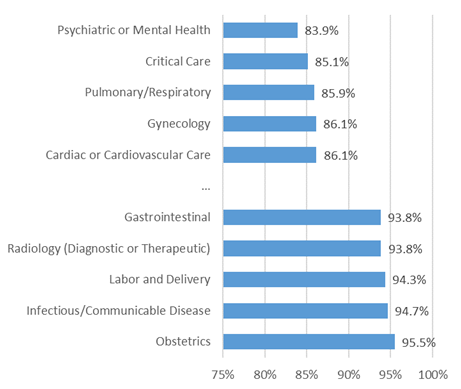
There is little difference in job satisfaction between nurses with and without patient care responsibilities.
Among nurses with patient care responsibilities, satisfaction varies across areas of specialization, ranging from a low of 83.9% for psychiatric or mental health nurses (including substance abuse and counseling), to a high of 95.5% for RNs specializing in obstetrics.
Exhibit 3a. Most Commonly Cited Reasons for Leaving Primary Nursing Position After December 31, 2017
RNs No Longer Working in Nursing
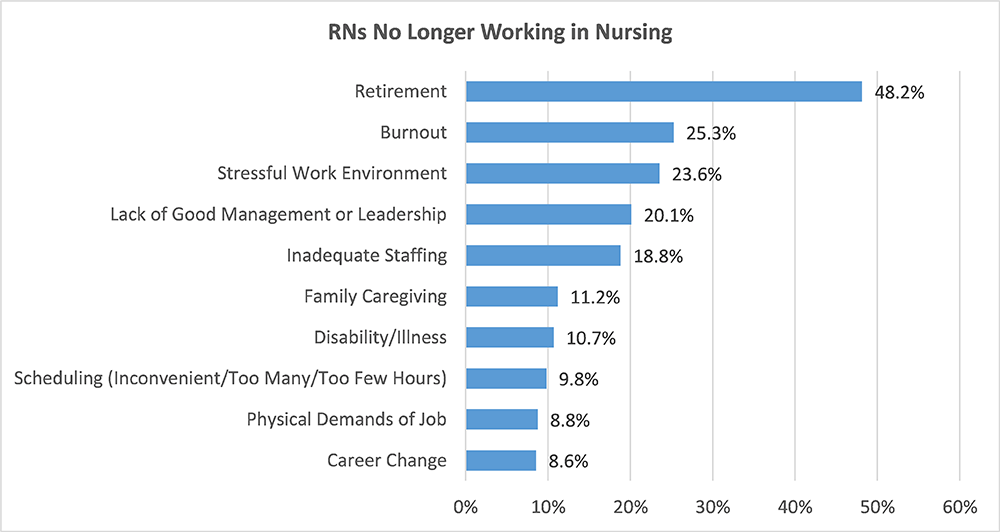
Detailed Description of Exhibit 3a
Exhibit 3b. RNs Still Employed in Nursing
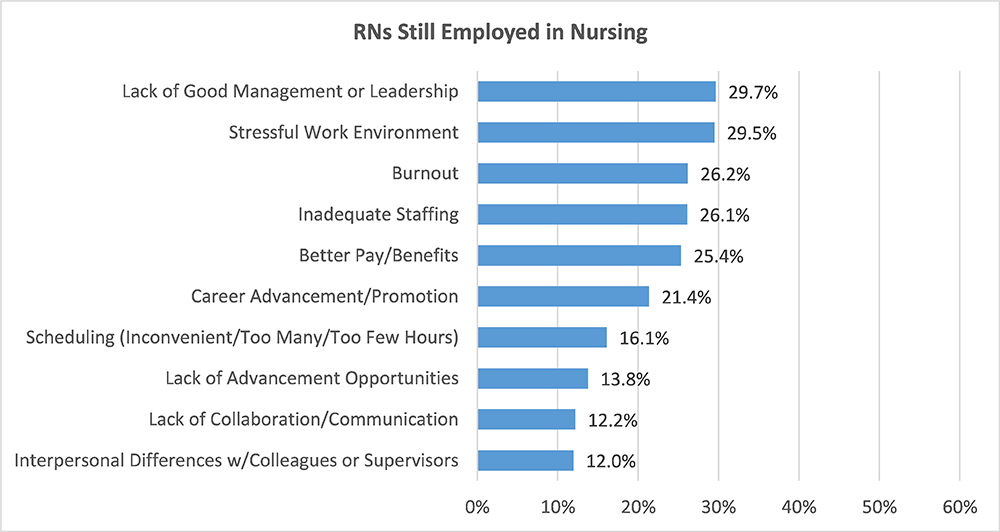
Despite generally high satisfaction among nurses, 12.8% of RNs left their primary nursing position between December 31, 2017, and the date they responded to the survey in 2018.
For those that left nursing, retirement was the most commonly given reason for leaving, followed by burnout, a stressful working environment, lack of good management or leadership, and inadequate staffing.
For those that left their primary position for another nursing position, lack of good management or leadership, a stressful working environment, and burnout were the most common reasons given.
Exhibit 4. Most Common Reasons Given for Considering Leaving Primary Nursing Position
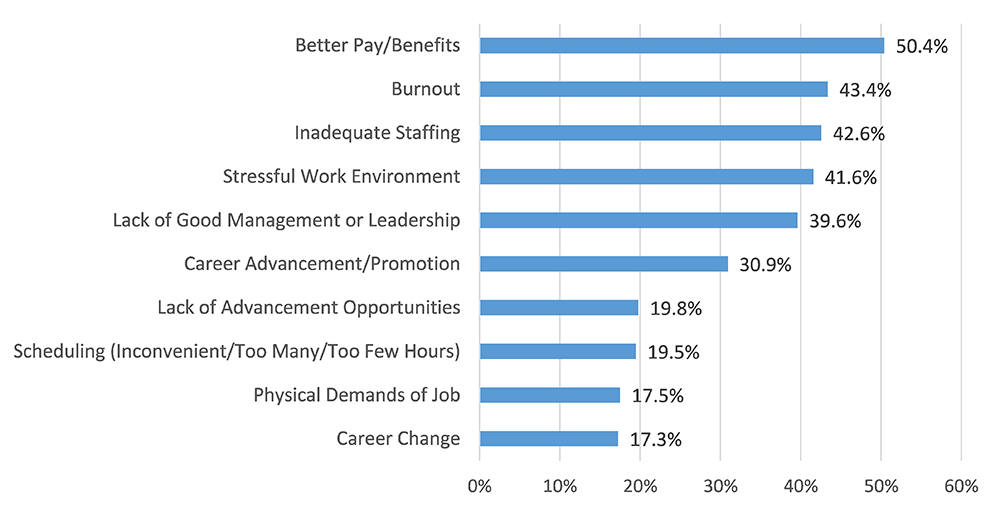
Of the RNs that remained in their primary nursing position between December 31, 2017, and the date they responded to the survey, more than half (54.6%) indicated that they have considered leaving their position at some point in the past. Nearly half (49.6%) indicated that they considered leaving their primary nursing position in the past year.
Better pay and benefits, burnout, inadequate staffing, a stressful work environment, and a lack of good management or leadership were the most common reasons cited for considering leaving.
For RNs that have considered leaving their primary nursing position, 18.2% plan to leave within the next year, while 27.4% indicated they plan to leave between one and three years from now.
Exhibit 6. Majority of RNs Considering Leaving Primary Position Plan to Continue in Nursing
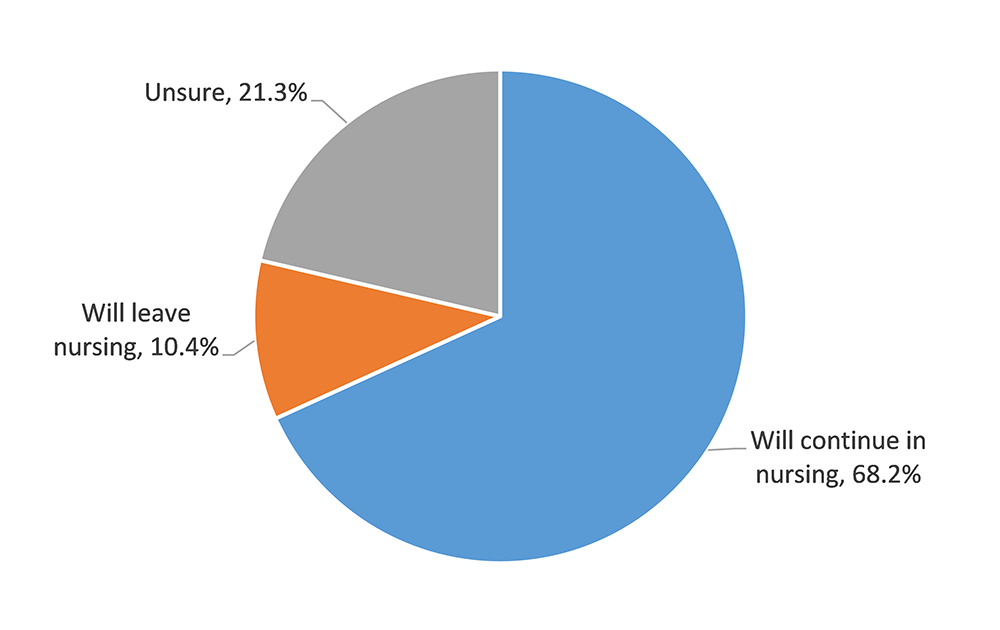
Most RNs (68.2%) that have considered leaving their primary nursing position plan to continue in nursing after leaving their current position. Only 10.4% indicated that they planned to leave nursing altogether, while 21.3% were unsure if they would continue in nursing or not.
Exhibit 7. Average Number of Hours Scheduled and Worked in a Typical Week
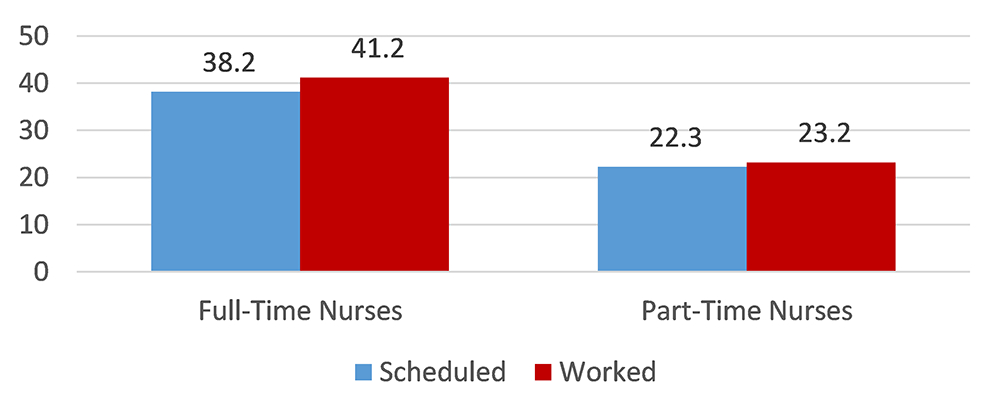
Another factor that may impact job satisfaction among RNs is scheduling and hours worked.
In 2017, the average nurse worked nearly three hours more than scheduled in a typical week (37.5 hours worked, compared to 34.9 hours scheduled).
Full-time nurses experienced a greater discrepancy between hours scheduled and hours worked than part-time nurses.
Exhibit 8. Distribution of Earnings from Primary Nursing Position (Full-Time and Part-Time RNs)
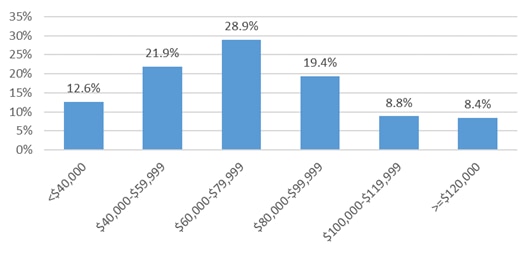
Better pay or benefits was a common reason cited by RNs for leaving or considering leaving their primary nursing position.
Overall, RNs earned a median income of $68,774 from their primary nursing position in 2017. Median earnings for full-time RNs were $73,929, while part-time RNs earned a median income of $39,985 from their primary nursing position. Exhibit 8 shows the distribution of earnings for all RNs in 2017.
The median annual earnings for RNs across all nursing-related employment was $69,898 for the year ended December 31, 2017.
Exhibit 9. Overall Median Earnings From Nursing Employment, Nurses With Secondary Nursing Employment in 2017
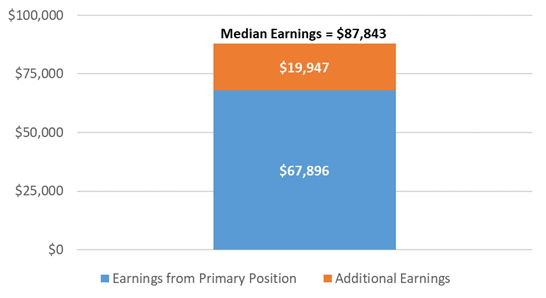
Nurses whose primary nursing position was part-time were slightly more likely to hold a secondary nursing position than their full-time counterparts (12.4% compared to 10.7%).
RNs with secondary nursing employment earned a combined median annual income of $87,843 from all nursing positions, a difference of nearly $20,000 compared to their earnings from their primary position ($67,896).
The National Sample Survey of Registered Nurses (NSSRN) is the longest running survey of registered nurses (RNs) in the United States. Since its inaugural assessment in 1977, the NSSRN has provided educators, health workforce leaders, and policymakers with key details and developments of the nursing workforce supply and includes information on the demographics, educational attainment, licenses and certifications, and employment characteristics of RNs in the United States.
In collaboration with the U.S Census Bureau, the National Center for Health Workforce Analysis administered the 10th NSSRN data collection in 2018. From April 2018 to October 2018, a total of 50,273 registered nurses completed the survey via a web form or a paper questionnaire with an unweighted response rate of 50.1% (49.1% weighted). This survey gathered data from participants with active RN licenses from all U.S. states revealing a comprehensive look into the RN and Advanced Practice Register Nurse (APRN) workforce.
Planning is currently underway for the 2022 NSSRN, which will collect data on RNs with active licenses as of December 31, 2021. This survey will provide an important point of reference for understanding how the nursing profession is impacted by the COVID-19 pandemic. We will update this brief when data from the 2022 NSSRN is available.
To learn more about the NSSRN or to download data and reports, visit National Sample Survey of Registered Nurses (NSSRN).